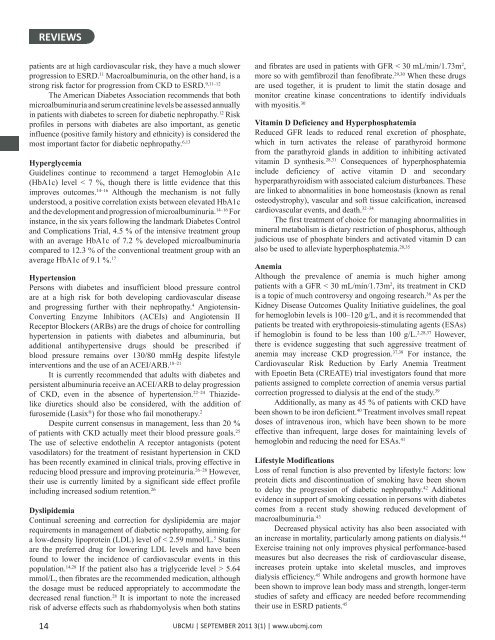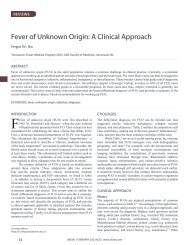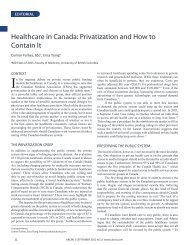Download full PDF - UBC Medical Journal
Download full PDF - UBC Medical Journal
Download full PDF - UBC Medical Journal
You also want an ePaper? Increase the reach of your titles
YUMPU automatically turns print PDFs into web optimized ePapers that Google loves.
REVIEWS<br />
patients are at high cardiovascular risk, they have a much slower<br />
progression to ESRD. 11 Macroalbuminuria, on the other hand, is a<br />
strong risk factor for progression from CKD to ESRD. 9,11–12<br />
The American Diabetes Association recommends that both<br />
microalbuminuria and serum creatinine levels be assessed annually<br />
in patients with diabetes to screen for diabetic nephropathy. 12 Risk<br />
profiles in persons with diabetes are also important, as genetic<br />
influence (positive family history and ethnicity) is considered the<br />
most important factor for diabetic nephropathy. 6,13<br />
Hyperglycemia<br />
Guidelines continue to recommend a target Hemoglobin A1c<br />
(HbA1c) level < 7 %, though there is little evidence that this<br />
improves outcomes. 14–16 Although the mechanism is not <strong>full</strong>y<br />
understood, a positive correlation exists between elevated HbA1c<br />
and the development and progression of microalbuminuria. 14–16 For<br />
instance, in the six years following the landmark Diabetes Control<br />
and Complications Trial, 4.5 % of the intensive treatment group<br />
with an average HbA1c of 7.2 % developed microalbuminuria<br />
compared to 12.3 % of the conventional treatment group with an<br />
average HbA1c of 9.1 %. 17<br />
Hypertension<br />
Persons with diabetes and insufficient blood pressure control<br />
are at a high risk for both developing cardiovascular disease<br />
and progressing further with their nephropathy. 4 Angiotensin-<br />
Converting Enzyme Inhibitors (ACEIs) and Angiotensin II<br />
Receptor Blockers (ARBs) are the drugs of choice for controlling<br />
hypertension in patients with diabetes and albuminuria, but<br />
additional antihypertensive drugs should be prescribed if<br />
blood pressure remains over 130/80 mmHg despite lifestyle<br />
interventions and the use of an ACEI/ARB. 18–21<br />
It is currently recommended that adults with diabetes and<br />
persistent albuminuria receive an ACEI/ARB to delay progression<br />
of CKD, even in the absence of hypertension. 22–24 Thiazidelike<br />
diuretics should also be considered, with the addition of<br />
furosemide (Lasix ® ) for those who fail monotherapy. 2<br />
Despite current consensus in management, less than 20 %<br />
of patients with CKD actually meet their blood pressure goals. 25<br />
The use of selective endothelin A receptor antagonists (potent<br />
vasodilators) for the treatment of resistant hypertension in CKD<br />
has been recently examined in clinical trials, proving effective in<br />
reducing blood pressure and improving proteinuria. 26–28 However,<br />
their use is currently limited by a significant side effect profile<br />
including increased sodium retention. 26<br />
Dyslipidemia<br />
Continual screening and correction for dyslipidemia are major<br />
requirements in management of diabetic nephropathy, aiming for<br />
a low-density lipoprotein (LDL) level of < 2.59 mmol/L. 5 Statins<br />
are the preferred drug for lowering LDL levels and have been<br />
found to lower the incidence of cardiovascular events in this<br />
population. 14,28 If the patient also has a triglyceride level > 5.64<br />
mmol/L, then fibrates are the recommended medication, although<br />
the dosage must be reduced appropriately to accommodate the<br />
decreased renal function. 28 It is important to note the increased<br />
risk of adverse effects such as rhabdomyolysis when both statins<br />
and fibrates are used in patients with GFR < 30 mL/min/1.73m 2 ,<br />
more so with gemfibrozil than fenofibrate. 29,30 When these drugs<br />
are used together, it is prudent to limit the statin dosage and<br />
monitor creatine kinase concentrations to identify individuals<br />
with myositis. 30<br />
Vitamin D Deficiency and Hyperphosphatemia<br />
Reduced GFR leads to reduced renal excretion of phosphate,<br />
which in turn activates the release of parathyroid hormone<br />
from the parathyroid glands in addition to inhibiting activated<br />
vitamin D synthesis. 28,31 Consequences of hyperphosphatemia<br />
include deficiency of active vitamin D and secondary<br />
hyperparathyroidism with associated calcium disturbances. These<br />
are linked to abnormalities in bone homeostasis (known as renal<br />
osteodystrophy), vascular and soft tissue calcification, increased<br />
cardiovascular events, and death. 32–34<br />
The first treatment of choice for managing abnormalities in<br />
mineral metabolism is dietary restriction of phosphorus, although<br />
judicious use of phosphate binders and activated vitamin D can<br />
also be used to alleviate hyperphosphatemia. 28,35<br />
Anemia<br />
Although the prevalence of anemia is much higher among<br />
patients with a GFR < 30 mL/min/1.73m 2 , its treatment in CKD<br />
is a topic of much controversy and ongoing research. 36 As per the<br />
Kidney Disease Outcomes Quality Initiative guidelines, the goal<br />
for hemoglobin levels is 100–120 g/L, and it is recommended that<br />
patients be treated with erythropoiesis-stimulating agents (ESAs)<br />
if hemoglobin is found to be less than 100 g/L. 2,28,37 However,<br />
there is evidence suggesting that such aggressive treatment of<br />
anemia may increase CKD progression. 37,38 For instance, the<br />
Cardiovascular Risk Reduction by Early Anemia Treatment<br />
with Epoetin Beta (CREATE) trial investigators found that more<br />
patients assigned to complete correction of anemia versus partial<br />
correction progressed to dialysis at the end of the study. 39<br />
Additionally, as many as 45 % of patients with CKD have<br />
been shown to be iron deficient. 40 Treatment involves small repeat<br />
doses of intravenous iron, which have been shown to be more<br />
effective than infrequent, large doses for maintaining levels of<br />
hemoglobin and reducing the need for ESAs. 41<br />
Lifestyle Modifications<br />
Loss of renal function is also prevented by lifestyle factors: low<br />
protein diets and discontinuation of smoking have been shown<br />
to delay the progression of diabetic nephropathy. 42 Additional<br />
evidence in support of smoking cessation in persons with diabetes<br />
comes from a recent study showing reduced development of<br />
macroalbuminuria. 43<br />
Decreased physical activity has also been associated with<br />
an increase in mortality, particularly among patients on dialysis. 44<br />
Exercise training not only improves physical performance-based<br />
measures but also decreases the risk of cardiovascular disease,<br />
increases protein uptake into skeletal muscles, and improves<br />
dialysis efficiency. 45 While androgens and growth hormone have<br />
been shown to improve lean body mass and strength, longer-term<br />
studies of safety and efficacy are needed before recommending<br />
their use in ESRD patients. 45<br />
14<br />
<strong>UBC</strong>MJ | SEPTEMBER 2011 3(1) | www.ubcmj.com










